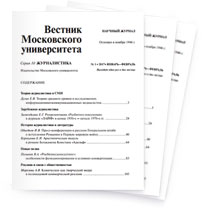The Place of LTT in the Genre Palette of Television News
Download paperPhD in Philology, Senior Lecturer at the Faculty of Journalism, Lomonosov Moscow State University, Moscow, Russia
e-mail: elina_nik@mail.ruSection: Television and Radio
This paper examines Life to tape as a separate genre of television information. The author’s aim was to demonstrate that in terms of information presentation LTT differs from other genres. For this, news releases of a number of Russian federal television channels were studied for the presence of LTT. The structure of LTT and its difference from the structure of “classic” reports were investigated. The author examined the LTT themes and analyzed the relevant footage for newsworthiness and problematicity. It was found that television workers turn to LTT when they have specific tasks to accomplish. One of these tasks is promptness. The LTT genre is more frequently used for informational purposes than for entertainment. The paper enables one to become aware of various methods of information presentation used by television newsrooms; to study LTT as a genre and understand its distinction from other ways of presenting news.
DOI: 10.30547/vestnik.journ.5.2019.7288References:
Agamyan E. Yu. (2014) L2T kak zhanr sovremennoy mediasfery [L2T as a Genre of Contemporary Media Sphere]. Vestn. Novosib. gos. un-ta. Seriya: Istoriya, filologiya: Zhurnalistika 13 (6): 42–49. (In Russian)
Alekberova A. A. (2011) Ponyatie i sistema televizionnykh zhanrov [The Concept and System of Television Genres]. In Sovremennaya filologiya: materialy Mezhdunar. nauch. konf. (g. Ufa, aprel’ 2011 g.) [Modern Philology: Proceedings of the International Scientific Conference (the city of Ufa, April 2011)]. Ufa. Pp. 230–234. (In Russian)
Dedov A. N. (2017) Tekhnologii televizionnoy zhurnalistiki: ucheb. posobie [Television Journalism Technologies: a Study Guide]. Izd-vo Kurg. Gos. un-ta. (In Russian)
Kachkaeva A. G. (2010) Istoriya televideniya v Rossii: mezhdu vlast’yu, svobodoy i sobstvennost’yu [History of Television in Russia: Between Power, Freedom and Ownership]. Istoriya novoy Rossii. (In Russian). Available at: http://www.ru-90.ru/ (accessed: 19.02.2019).
Kislaya L. N. (2015) Metod vklyuchennogo nablyudeniya kak prototip televizionnogo layf-tu-teyp [Method of Participant Observation as a Prototype of Life to Tape on Television]. Vestn. Chelyab. gos. un-ta. Seriya: Filologiya. Iskusstvovedenie 5 (94): 219–224. (In Russian)
Knyazev A. А. (2001) Osnovy telezhurnalistiki i telereportazha. Uchebnoe posobie [Fundamentals of Television Journalism and Television Reporting]. Bishkek: KRSU. (In Russian)
Kolesnichenko A. V. (2008) Prakticheskaya zhurnalistika: ucheb. posobie [Practical Journalism. A Study Guide]. Moscow: Izd-vo Mosk. un-ta. (In Russian)
Kovtun V. G. (2001) Tele- i radiopublitsistika [TV and Radio Journalism]. SPb. (In Russian)
Kuznetsov G. V., Tsvik V. L., Yurovskiy A. Ya. (eds.) (2005) Televizionnaya zhurnalistika. 5-e izd. [Television Journalism, 5th ed.]. Moscow: Izd-vo Mosk. un-ta; Nauka. (In Russian)
Mel‘nikova E. (2013) Kontent-analiz televizionnoy programmy peredach [Content Analysis of a TV Guide]. Vestnik MGUP 6: 232–236. (In Russian)
Shostak M. I. (2003) Reporter: professionalizm i etika: ucheb. posobie [Reporter: Professionalism and Ethics: a Study Guide]. Moscow: RIP-holding Publ. (In Russian)
Udovichenko R. V. (2011) Zhanrovye osobennosti razvlekatel‘nogo televideniya na primere teleprogramm kholdinga «STS Media» [Genre Characteristics of Entertainment Television: a Case Study of Television Programs of the STS Media Holding]. Nauchnaya mysl’ Kavkaza 2: 148–157. (In Russian)






